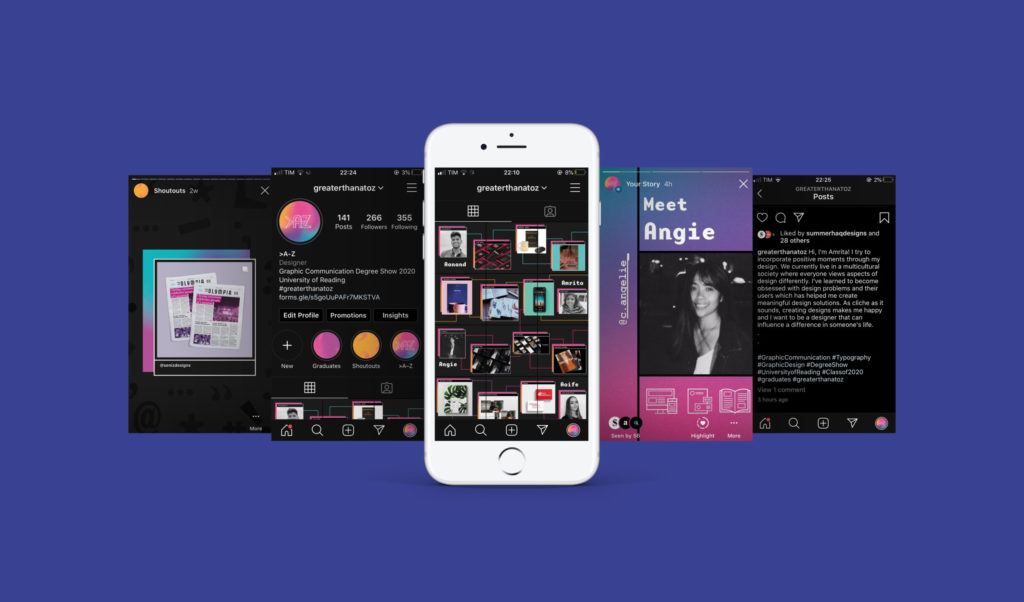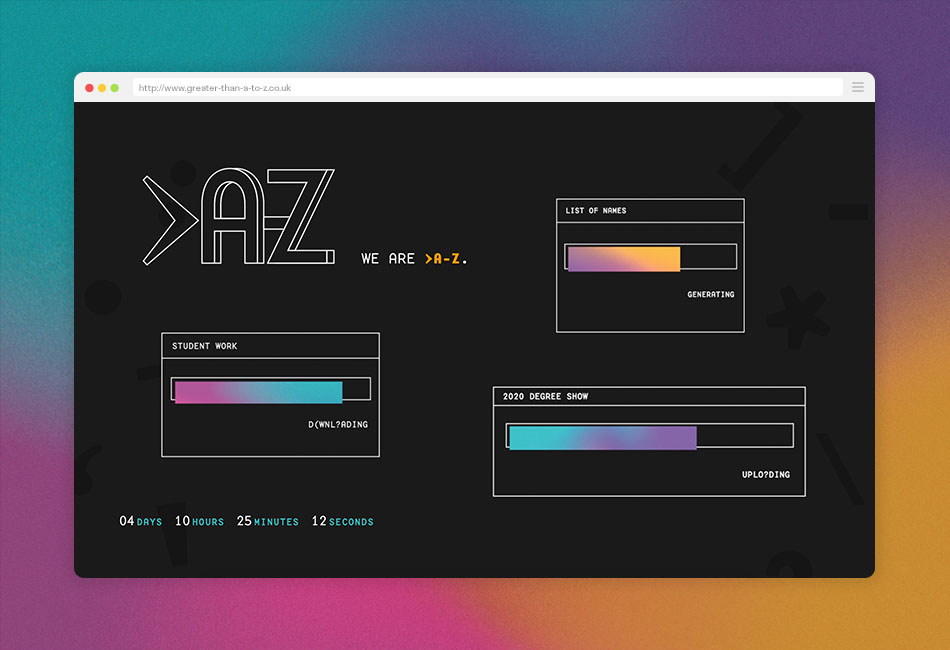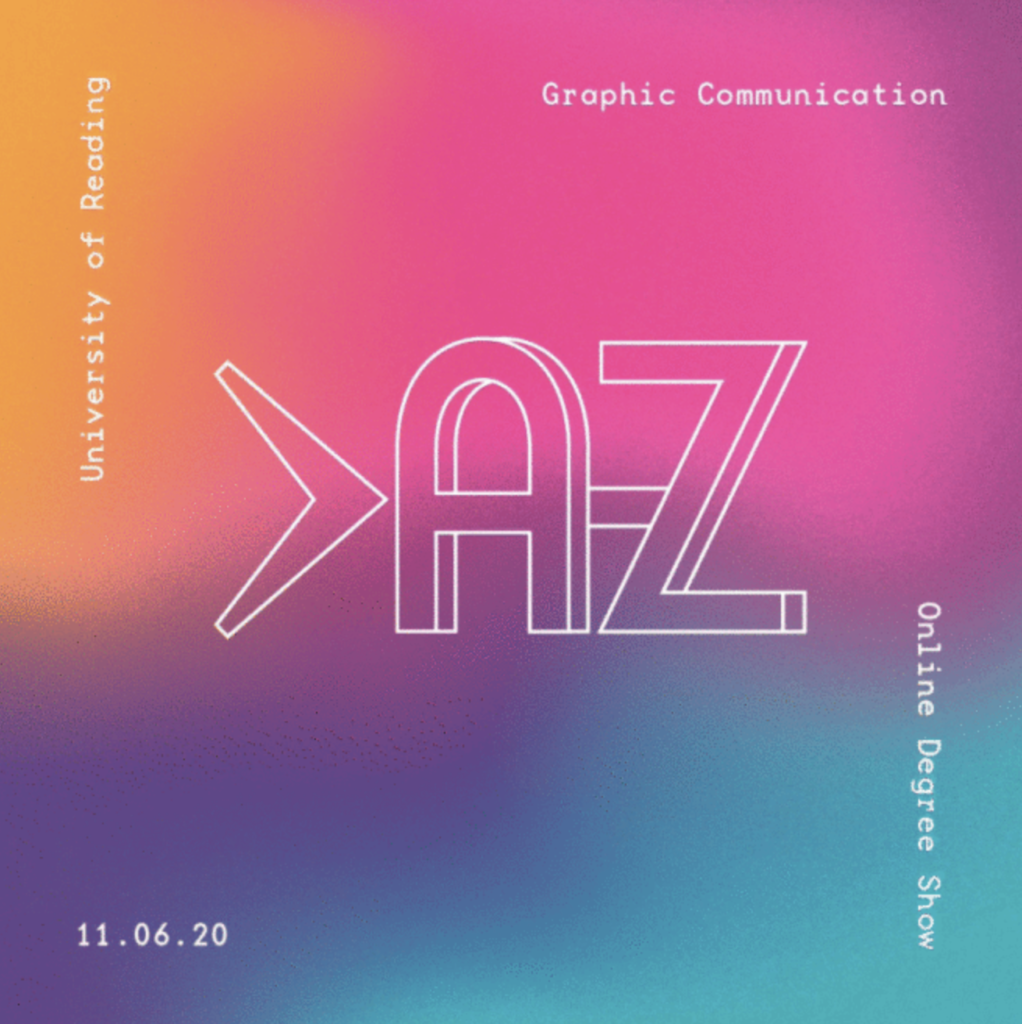Background
Each year the Typography & Graphic Communication Department organises and hosts an annual show to showcase work produced by finalists of the BA and MA degree classification. Each year the show is organised and run by a small group of students who decide on a theme that encompasses the range of work of the graduating class. A team of 9 graduating Typography students were responsible for creating a range of promotional material for the design and delivery of the event in a cohesive and orderly way. Given the recent events of the Covid-19 outbreak, the physical degree show had been cancelled and shifted to an online presence.
Deliverables
The key deliverables for this project were:
- The degree shows visual identity
- An email invite created and sent via MailChimp
- An Instagram to promote and bring awareness to the degree show
- A website with information on the event and the students work
The aim of these outputs is to primarily to emphasize the work of the graduating class, and provide them with as much publicity and support we can to aid them in finding a graduate job. The launch for the show is set for the 11th of June, 2020.
Allocating roles
As this year’s degree show attracted 9 students, it was decided that it would be beneficial to split up the roles between us, to successfully and effectively fulfill the requirements of this real job. At the start of this job the role of creative lead was allocated to myself, which meant that I was the sole point of contact for all stakeholders involved in the project. In regard to the rest of the team, the roles were split up as ‘invites’, ‘website’ and ‘social’. In my role as creative lead, it was my responsibility to ensure that all teams were supported adequately and received necessary feedback to their designs. Although Rob was technically the supervisor and Eric the client, it was interesting to be the ‘middle-man’ between client and supervisor and the rest of the team. Simply put, my role was a ‘mini real job supervisor’.
Implications of Covid-19
Sadly, due to the global pandemic known as COVID-19, we were faced with some rather difficult situations. The biggest obstacle was the closure of the University due to Government guidelines. Subsequently, our approach to the show changed, and became predominantly online. As well as this, the way we communicated as a group and had our weekly meetings became conducted through either the Department online classrooms or Zoom. Moreover, due to the move to a more digital approach, Instagram was required to be utilised more in order to extend the reach of graduate work. On another note, the invitations were no longer able to be printed and these had to be designed and distributed using MailChimp. Although not directly linked to Covid-19, this posed its own challenge of collecting a mailing list. To collect data that the university could then keep for following years, a google form was created and distributed on social media like Instagram and LinkedIn encouraging people to sign up.
Collaboration
This project involved working within a larger group of students. Our team communicated through a weekly meeting enabling us to delegate tasks and troubleshoot any glitches we had quickly and easily between us – (once universities closed, this was moved online). The regular attendance from one person from each sub team at the real jobs meetings gave us clear direction for our next steps allowing the project to move forward. This was an efficient way to stay organised and work toward our deadline, whilst also using both Trello and Messenger to contact each other outside of our weekly meetings. Attending the real job meeting gave us a chance to pitch our concepts to our year group, who at the end of the day were the real clients of this project. It provided us a time where we could ask for opinions and feedback on aspects like colour, layout and theme, so we were not just assuming what the year group would like. Getting everyone in our year group involved was a core value for us as a team, as this wasn’t just our show. In adopting this collegiate approach I was praised for thinking about the rest of our peers.
Though the tasks we did were sometimes individual, we always kept in touch for guidance and advice ensuring we were both on track with the real job and with our own objectives. Trello was an effective tool as we were able to monitor progress, tasks, and deadlines, encouraging us to consider all aspects of the project right from the start and not lose sight of our final outcome.
However, there were times when communicating with the team from a perspective of leadership proved difficult. When asserting a sense of leadership and creative ‘lead-like’ attitudes, this was not always well received by others in the team. Due to being friends with everyone in the group, this clouded both mine and the others judgment of my position as creative lead. Although this was occasionally the case, our communication and strong team bond allowed us to work effectively as a group and achieve a standard of work that we were happy with. We excelled in achieving an exemplary final outcome that has been praised by our client to be:
“[looking] super!”
Leadership
In my role, good leadership and management was imperative to successfully deliver the curation of the 2020 degree show. Having had past experience in a role of management as supervisor at New Look, I already knew and understood the basics to effectively manage a team and support their needs. Although this knowledge was specific to retail, it was still transferable to my role as creative lead. A few of the key principles I followed whilst working as creative director for the 2020 degree show was:
- Firstly always be approachable and accessible – making sure no one is scared to come ask me for help
- Secondly set clear objectives and creative standards for the week so that everyone is able to understand them.
- Finally create a culture of honest engagement, so that everyone feels they can openly discuss their opinions and suggestions.
The primary obstacle I found in this role was being friends with everyone in the team. This initially posed an issue as I would be viewed more as a friend than a team manager, and messages and communication would get lost between us. However, this was overcome by me making it clear that when we were in our meetings, these were to be professional and to acknowledge the fact I was in a leadership role to do a job. This proved to be effective as one member of the team stated that I did:
“a great job in organising our roles and keeping everyone on track”
whilst a lecturer found my approach and work rate
“…exemplary. He has a collegiate approach with his peers, while also helping to motivate and inspire the group. He has listened to and respected everyone’s specific role, letting their creativity and enthusiasm flourish. He has been the most effective project leader that I can recall from the past 5 years.”
Design process
At the start of the project, all members of our team generated different concepts and ideas for the degree show. After copious amounts of ideation and crazy 8s we decided to go with the theme of <A-Z (Greater than A to Z). To summarise our concept: “Communication has been the foundation of our development as designers. At Reading, we have built our design skills in many areas. In everything we have done, punctuation – graphic and typographic – has helped form our designing and refine our writing, bringing meaning, nuance and communication. Attention to detail defines our work: it is more than just A–Z.” This was then implemented and developed across all three outputs: invite, social and web. To implement this, the different outputs played with the scale and the rotation of symbols and marks to create something that was <A-Z.
This was enhanced by our visual identity – which was based on holographic foil. The vibrancy and quality associated with it mirrors that of the personality of our year groups. The holographic foiling was initially going to be used on the printed invites however, as these were no longer feasible to print, we decided to take this approach and style digital. At this stage we all developed various holographic gradients.
Once the visual style was confirmed, all teams were able to develop different assets that adhered to the brand guidelines.




Lessons and reflections
Through this Real Job, both as a group and individually we faced many challenges but also learnt a variety of new skills. One of the issues faced was gathering student work from our peers, specifically in formats that we requested. The process involved a lot of back and forth between our peers and the degree show team, especially when gathering updated pieces. Eventually, to overcome this, we set up a drive that everyone could upload their work rather than chasing over emails.
Moreover, I’ve gained insight into the benefits of working together with team members of different strengths. Having someone on the team dedicated to the website and another person leading the print design allowed the team to focus on each deliverable. In addition, it became clear very quickly the benefit of organising content through shared folders help keep things on track.
Finally, in taking on the role of creative director it has given me a taste of what it is like curating and directing such a large design project. As this is eventually my career goal, this was a fantastic opportunity to see what the role is like and face some of the challenges with the role, yet be able to celebrate the many successes, preparing me for my future.
If you would like to view the 2020 degree show, click here http://www.greater-than-a-to-z.co.uk or alternatively check us out on Instagram @greaterthanatoz

